First of all, in addition to one carat (size), the parameters of diamonds have other parameters. If they are all calculated, there will be:
Color 23 X Clarity 11 X Cut 5 X Polish 5 X Symmetry 5 X Fluorescence 5 X Cut 12 X Milky Green 5 X Certificate 6 = 56,925,000 choices
In short, the cost price of a 1-carat diamond: is USD4,500 - USD25,000
The parameters corresponding to the specific price can see in the table below:
Diamond grades are divide into 1CT I color; 1CT H color; 1CT G color; 1CT F color; 1CT E color; 1 CT D color
The corresponding price is also getting more expensive, ranging from USD4,500 (I color) to USD25,000 (D color, of course, we are talking about a broad range, and the specific price should go to the local jewelry store.
★The round diamonds we are talking about here, in professional terms: brilliant-cut diamonds, the price of other special-shaped diamonds will be lower than that of round diamonds;
★The diamonds at the above prices are: Size: 1 carat; Color: I color or above; Clarity: SI1 or above; Cut: 3EX; Because diamonds below any of these parameters can see with apparent defects from the naked eye, we do not recommend buying them, because such diamonds are no longer available in terms of aesthetic value, collection value or value preservation;
Size - Drill Selection Methodology:
1. One-carat diamonds are of aesthetic and collection value, but the price is relatively high. Not everyone must have them. Friends should do what they can and don't force it; the price of 70-80 diamonds is only one of the same grade. Half of the carat diamond's size is also perfect. We recommend and preferred by the public. The price of a 50-point diamond is more in line with the budget of our working class, and it is also the mainstream purchase direction; a 30-point diamond already has the size of a ring center diamond, which is also a good choice.
2. Try to choose diamonds with a weight greater than or equal to an integer, such as 51 points and 1.01 carats, to exclude diamonds rounded into integers but not heavy enough.
Second, the color of the diamond:
D E F three are close to colorless. If the budget is sufficient, the preferred choice
Color I is barely acceptable, and colors below I are not recommended for purchase.
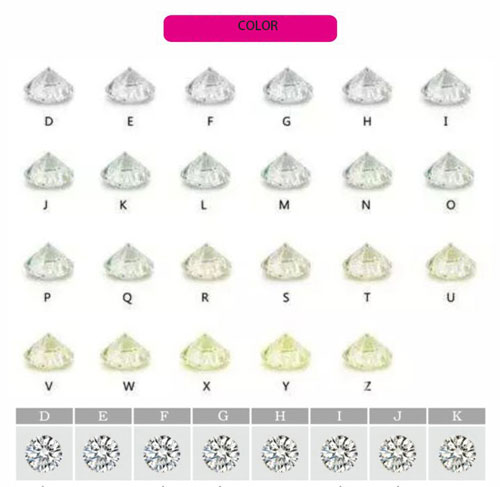
Color - Diamond Selection Methodology:
There is a consensus in the diamond color industry: "H color" is an intermediate value, D-E-F-G colors above H color classify as "white," and I-J-K-L.... below H color classify as "yellow." It is not a scientific statement, but it is very telling. Because we can also see from the above picture that the H color starts to have a yellow tone that the naked eye can detect. For diamonds of H color and above, it is difficult to tell the difference in color. In fact, for professional diamond graders, it isn't easy to distinguish the color difference of diamonds in the D-G range without colorimetric tools;
In terms of price, when other parameters are the same, the price will increase by about 10-15% for each grade of diamond color;
3. The clarity of the diamond:
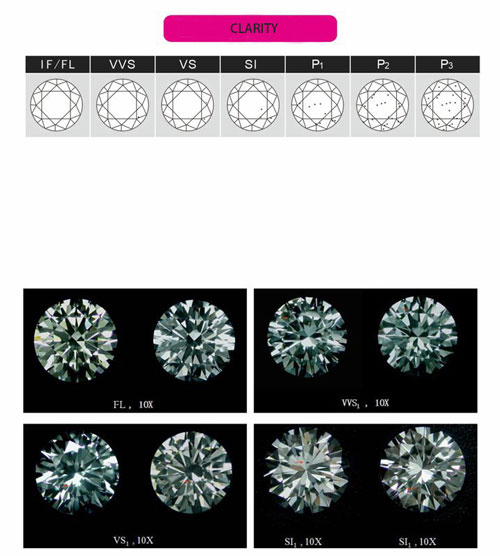
Clarity - Diamond Selection Methodology:
First of all, we still have to declare that the flaws and inclusions we are talking about are tiny under a 10x magnifying glass. How small are they? Personal test, after I pointed out the flaw position of a 1 carat SI1 clarity diamond, at least half of my friends looked at it for a long time with a 10x magnifying glass and said: I can't see it at all!
Secondly, although "clarity" is an essential dimension of diamonds, when we encounter multiple-choice questions of "high color, low cleanliness" and "low color, high cleanliness" at the same price, I will choose "high color and high cleanliness" without hesitation. Low color and clean." Because clarity is the only parameter of the 4Cs of diamonds that is barely noticeable to the naked eye. (Well, if you have to use a 5-carat 10-carat SI2 to see the flaws with the naked eye, I can only say, local tyrant, beautiful work!)
Same conditions other parameters, the price will increase by about 5-15% for each grade of diamond clarity (depending on the specific requirements of the flaw);
Let's summarize the selection of diamond clarity:
♢ Although IF-FL is pure and flawless, it is rare in quantity and expensive, so it is rare to find it;
♢ VVS1 / VVS2 can buy with eyes closed, but the price is relatively high, time is precious, and the budget is sufficient;
♢VS1 / VS2 The price is balanced and cost-effective, but pay attention to the types and locations of defects mentioned above;
♢SI1 / SI2 are relatively cheap; it is best to have an expert partner or find a sincere seller and look carefully at the flaws yourself;
♢Do not select the below SI2.
4. Cut - Methodology of Diamond Selection:
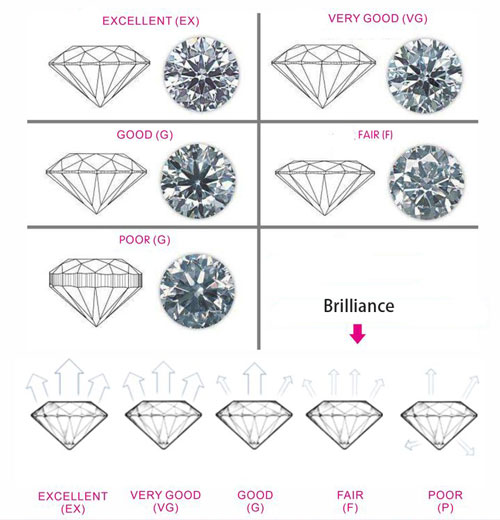
♢Cutwork is a crucial parameter to determine whether the fire of a diamond shines, and it should pay considerable attention to the selection of diamonds. It recommends choosing the 3EX Cut directly. If there is an additional condition, it is to select the ratio carefully :)
♢ Although all three items are essential, if you must prioritize, please refer to Cut≥ Symmetry ≥ Polishing
So, to sum up: 3EX can not be less; the minimum standard: EX (Cut), VG (polished), EX (symmetrical)
5. About Eight Hearts and Eight Arrows
As a unique visual effect of a round cut, Hearts and Arrows endow with a significant meaning. Usually, diamonds that can reach 3EX Cut can see. You can also ask merchants to provide top and bottom views if they compare with the above picture. You can see the pros and cons!
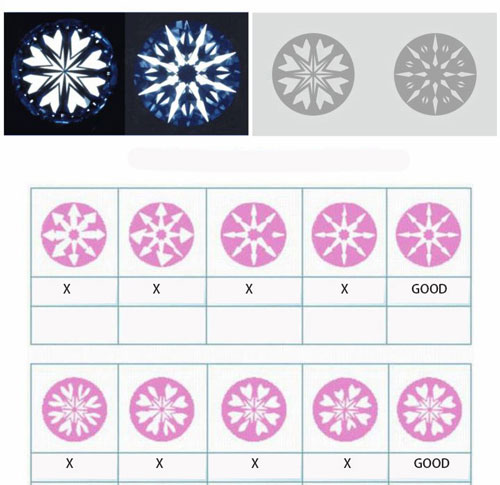
6. About Fluorescence
✡Fluorescence-Diamond Selection Methodology:
Fluorescence is a natural phenomenon of diamonds as mineral crystals and is also a congenital disability in value, as this halo obscures the diamond's brilliance. Therefore, when selecting diamonds, we should avoid fluorescent diamonds as much as possible and choose None non-fluorescent diamonds; if the budget is limited, at most Faint micro-fluorescent diamonds can be accepted.
Seven, about milk coffee green
Regarding the hidden properties of diamonds, these types of diamonds should avoid in the diamond buying process.
The cream diamond has a visual layer of white fog, neither fluorescent nor color. Instead, it's a mass of tiny dust-like inclusions. But it belies the fire and pure transparency of the diamond.
The cost of a cream drill is meager.
Green or coffee-toned diamonds are also a hue that some natural diamonds have, which can cause the diamond to deviate from its color and become opaque or dull.
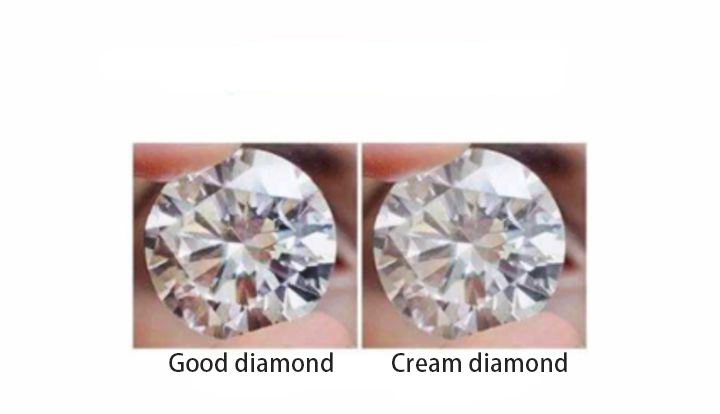
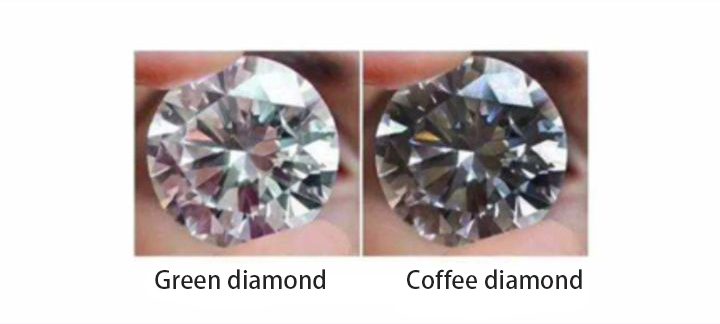
Next, we discuss an interesting question:
Why do the market prices of diamonds vary so much? Is it because the more expensive the diamond, the more genuine and the better the quality?
The answer is no because diamonds, as a natural mineral gemstone, are all the same carbon crystals, just like the steel we use to build cars and the gasoline we use to drive them. A company is different, and its nature changes.
The massive difference in the price of diamonds of the same grade is mainly due to the premium of different jewelry brands!
For example, for the 1-carat diamond I mentioned above, the parameters are all medium-level diamonds (F color, VS1 clarity, 3EX, non-fluorescence), and the cost price is about 55,000 yuan; In different brands, the prices are as follows:
☆In top international brand stores, such as Harry Winston and Graff, the price will be as high as USD50,000;
☆In the international first-line brand stores, such as Cartier and Tiffany, its price also needs to be more than USD50,000
Don't you think it's fantastic to see these numbers? Maybe in your opinion, hundreds of thousands of diamond rings can be bought in upstream channels at only 1/10 of the price.
Contact: Lee
Phone: 008615812571762
E-mail: le@lerings.com
Whatsapp:008615812571762
Add: 3F,#4 ShangXing Road, XingAn ChangAn Town, DongGuan,China
We chat